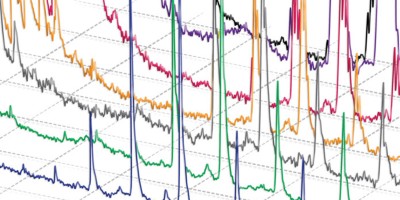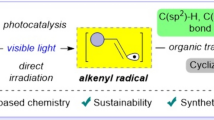Abstract
Aryl iodides are important precursors in synthetic chemistry that form carbon–carbon and carbon–heteroatom bonds. Most methods use transition-metal catalysts, which need to be scrupulously removed before the compounds can be used in the pharmaceutical and electronics industries, where only parts-per-million levels of transition metals are allowed. The aromatic Finkelstein iodination reaction is a powerful method of preparing valuable aryl iodides from cheap but less reactive aryl bromides and chlorides. This protocol describes a transition metal–free method for a photo-induced aromatic Finkelstein iodination reaction that is performed at room temperature (20 °C). With common aromatic bromides and sodium iodide (NaI) as the starting materials, as well as a catalytic amount of I2 as an additive, the corresponding aromatic iodides can be synthesized in yields ranging from 56 to 93% under UV light irradiation in the absence of any metal catalysts. Various functional groups such as nitrile, ester and amino can be tolerated, which will facilitate the further functionalization of the aromatic iodides. The procedure normally requires 38–40 h to complete.










Similar content being viewed by others
References
Bunnett, J.F. & Zahler, R. Aromatic nucleophilic substitution reactions. Chem. Rev. 49, 273–412 (1951).
Bolm, C., Hildebrand, J.P., Muñiz, K. & Hermanns, N. Catalyzed asymmetric arylation reactions. Angew. Chem. Int. Ed. 40, 3284–3308 (2001).
Popov, I., Lindeman, S. & Daugulis, O. Copper-catalyzed arylation of 1H-perfluoroalkanes. J. Am. Chem. Soc. 133, 9286–9289 (2011).
Bunevičius, R., Kažanavičius, G., Žalinkevičius, R. & Prange, A.J. Effects of thyroxine as compared with thyroxine plus triiodothyronine in patients with hypothyroidism. N. Engl. J. Med. 340, 424–429 (1999).
Pimlott, S.L. & Sutherland, A. Molecular tracers for the PET and SPECT imaging of disease. Chem. Soc. Rev. 40, 149–162 (2011).
Hallouard, F., Anton, N., Choquet, P., Constantinesco, A. & Vandamme, T. Iodinated blood pool contrast media for preclinical X-ray imaging applications. Biomaterials 31, 6249–6268 (2010).
Seevers, R.H. & Counsell, R.E. Radioiodination techniques for small organic molecules. Chem. Rev. 82, 575–590 (1982).
Barluenga, J., González, J.M., Martín, M.A.G., Campos, P.J. & Asensio, G. Acid-mediated reaction of bis(pyridine)iodonium(I) tetrafluoroborate with aromatic compounds. A selective and general iodination method. J. Org. Chem. 58, 2058–2060 (1993).
Takagi, K., Hayama, N. & Inokawa, S. The in situ-generated nickel(0)-catalyzed reaction of aryl halides with potassium iodide and zinc powder. Bull. Chem. Soc. Jpn. 53, 3691–3695 (1980).
Yang, S.H., Li, C.S. & Cheng, C.H. Halide exchange reactions between aryl halides and alkali halides catalyzed by nickel metal. J. Org. Chem. 52, 691–694 (1987).
Sheppard, T.D. Metal-catalysed halogen exchange reactions of aryl halides. Org. Biomol. Chem. 7, 1043–1052 (2009).
Klapars, A. & Buchwald, S.L. Copper-catalyzed halogen exchange in aryl halides: an aromatic Finkelstein reaction. J. Am. Chem. Soc. 124, 14844–14845 (2002).
Casitas, A., Canta, M., Solà, M., Costas, M. & Ribas, X. Nucleophilic aryl fluorination and aryl halide exchange mediated by a CuI/CuIII catalytic cycle. J. Am. Chem. Soc. 133, 19386–19392 (2011).
Cant, A.A., Bhalla, R., Pimlott, S.L. & Sutherland, A. Nickel-catalysed aromatic Finkelstein reaction of aryl and heteroaryl bromides. Chem. Commun. 48, 3993–3995 (2012).
Chen, M., Ichikawa, S. & Buchwald, S.L. Rapid and efficient copper-catalyzed Finkelstein reaction of (hetero)aromatics under continuous-flow conditions. Angew. Chem. Int. Ed. 54, 263–266 (2015).
Li, L. et al. Photo-induced metal-catalyst-free aromatic Finkelstein reaction. J. Am. Chem. Soc. 137, 8328–8331 (2015).
M'Halla, F., Pinson, J. & Saveant, J.M. The solvent as H-atom donor in organic electrochemical reactions. Reduction of aromatic halides. J. Am. Chem. Soc. 102, 4120–4127 (1980).
Rasmusson, M. et al. Photodissociation of bromobenzene in solution. Chem. Phys. Lett. 367, 759–766 (2003).
Acknowledgements
This work was financially supported by the Canada Research Chair (Tier 1) foundation, the Natural Sciences and Engineering Research Council of Canada, the Fonds de recherchésur la nature et les technologies, the Canada Foundation for Innovation (CFI) and McGill University.
Author information
Authors and Affiliations
Contributions
L.L. and W.L. designed the study; L.L. optimized and performed the experiments and W.L. discovered the initial reaction; L.L., W.L., X.M., C.-J.L. and Z.M. wrote the manuscript; C.-J.L. and Z.M. initiated and supervised the project; all authors discussed the results and commented on the manuscript.
Corresponding authors
Ethics declarations
Competing interests
The authors declare no competing financial interests.
Rights and permissions
About this article
Cite this article
Li, L., Liu, W., Mu, X. et al. Photo-induced iodination of aryl halides under very mild conditions. Nat Protoc 11, 1948–1954 (2016). https://doi.org/10.1038/nprot.2016.125
Published:
Issue Date:
DOI: https://doi.org/10.1038/nprot.2016.125
- Springer Nature Limited
This article is cited by
-
Catalyst-free Photochemical Bromination of Unprotected Aromatic Amino Acid Derivatives by Using a Rotating Ultraviolet Photoreactor
Chemical Research in Chinese Universities (2022)
-
Photoiodization of toluene in a microflow platform
Journal of Flow Chemistry (2022)
-
A cross-dehydrogenative C(sp3)−H heteroarylation via photo-induced catalytic chlorine radical generation
Nature Communications (2021)





